Tropical Forest Monitoring: Challenges and Recent Progress in Research
Abstract
:1. Introduction
1.1. Tropical Forests
1.2. Forest Monitoring
1.3. Needs and Challenges for Forest Monitoring
1.4. Capacities for Forest Monitoring
1.5. Identifying Research Challenges
2. Materials and Methods
2.1. Literature Review
2.2. Characterization of the Countries’ Conditions
2.2.1. Biophysical Conditions
2.2.2. Anthropogenic Influences
2.2.3. Forest Monitoring Capacities
2.3. Correlation between the Studies and the Countries Characteristics and Level of Challenge
3. Results
3.1. Systematic Literature Review
3.2. First Author Affiliation
3.3. Correlation between the Studies Performed and the Countries Characteristics
4. Discussion
4.1. Distribution, Categories, and the Country of the Affiliation of the First Authors of Recent Research
4.2. Needs and Challenges for Forest Monitoring
4.3. Implications for Future Research Efforts
5. Conclusions
Author Contributions
Funding
Informed Consent Statement
Data Availability Statement
Conflicts of Interest
References
- FAO; UNEP. The State of the World’s Forests: Forests, Biodiversity and People; FAO: Rome, Italy, 2020; ISBN 9789251324196. [Google Scholar]
- Pan, Y.; Birdsey, R.A.; Fang, J.; Houghton, R.; Kauppi, P.E.; Kurz, W.A.; Phillips, O.L.; Shvidenko, A.; Lewis, S.L.; Canadell, J.G.; et al. A Large and Persistent Carbon Sink in the World’s Forests. Science 2011, 333, 988–993. [Google Scholar] [CrossRef] [Green Version]
- Miura, S.; Amacher, M.; Hofer, T.; San-Miguel-Ayanz, J.; Thackway, R. Protective Functions and Ecosystem Services of Global Forests in the Past Quarter-Century. For. Ecol. Manag. 2015, 352, 35–46. [Google Scholar] [CrossRef] [Green Version]
- Hosonuma, N.; Herold, M.; de Sy, V.; de Fries, R.S.; Brockhaus, M.; Verchot, L.; Angelsen, A.; Romijn, E. An Assessment of Deforestation and Forest Degradation Drivers in Developing Countries. Environ. Res. Lett. 2012, 7. [Google Scholar] [CrossRef]
- Carter, S.; Herold, M.; Avitabile, V.; de Bruin, S.; de Sy, V.; Kooistra, L.; Rufino, M.C. Agriculture-Driven Deforestation in the Tropics from 1990–2015: Emissions, Trends and Uncertainties. Environ. Res. Lett. 2018, 13, 014002. [Google Scholar] [CrossRef] [Green Version]
- IUCN Deforestation and Forest Degradation. Available online: https://www.iucn.org/resources/issues-briefs/deforestation-and-forest-degradation (accessed on 1 May 2021).
- Foley, J.A.; DeFries, R.; Asner, G.P.; Barford, C.; Bonan, G.; Carpenter, S.R.; Chapin, F.S.; Coe, M.T.; Daily, G.C.; Gibbs, H.K.; et al. Global Consequences of Land Use. Science 2005, 309, 570–574. [Google Scholar] [CrossRef] [Green Version]
- Morris, R.J. Anthropogenic Impacts on Tropical Forest Biodiversity: A Network Structure and Ecosystem Functioning Perspective. Philos. Trans. R. Soc. B Biol. Sci. 2010, 365, 3709–3718. [Google Scholar] [CrossRef] [PubMed] [Green Version]
- Salvini, G.; Herold, M.; de Sy, V.; Kissinger, G.; Brockhaus, M.; Skutsch, M. How Countries Link REDD+ Interventions to Drivers in Their Readiness Plans: Implications for Monitoring Systems. Environ. Res. Lett. 2014, 9, 074004. [Google Scholar] [CrossRef] [Green Version]
- Ferretti, M. Forest monitoring. An introduction. In Developments in Environmental Science; Elsevier Ltd.: Amsterdam, The Netherlands, 2013; Volume 12, pp. 3–18. [Google Scholar]
- Romijn, E.; Lantican, C.B.; Herold, M.; Lindquist, E.; Ochieng, R.; Wijaya, A.; Murdiyarso, D.; Verchot, L. Assessing Change in National Forest Monitoring Capacities of 99 Tropical Countries. For. Ecol. Manag. J. 2015. [Google Scholar] [CrossRef] [Green Version]
- Achard, F.; DeFries, R.; Eva, H.; Hansen, M.; Mayaux, P.; Stibig, H. Pan-Trop Monit Deforestation. Res. Lett. 2007, 2, 45022–45033. [Google Scholar] [CrossRef] [Green Version]
- Federici, S.; Lee, D.; Herold, M. Forest Mitigation: A Permanent Contribution to the Paris Agreement? WorNing Pap 2017. [Google Scholar] [CrossRef]
- Keenan, R.J.; Reams, G.A.; Achard, F.; de Freitas, J.V.; Grainger, A.; Lindquist, E. Dynamics of Global Forest Area: Results from the FAO Global Forest Resources Assessment 2015. For. Ecol. Manag. 2015, 352, 9–20. [Google Scholar] [CrossRef]
- Petersen, R.; Davis, C.; Herold, M.; de Sy, V. Tropical Forest Monitoring: Exploring the Gaps between What Is Required and What Is Possible for REDD+ and Other Initiatives; World Resources Institute: Washington, DC, USA, 2018; pp. 1–5. [Google Scholar]
- Davies, S.J.; Abiem, I.; Abu Salim, K.; Aguilar, S.; Allen, D.; Alonso, A.; Anderson-Teixeira, K.; Andrade, A.; Arellano, G.; Ashton, P.S.; et al. ForestGEO: Understanding Forest Diversity and Dynamics through a Global Observatory Network. Biol. Conserv. 2021, 253, 108907. [Google Scholar] [CrossRef]
- Randin, C.F.; Ashcroft, M.B.; Bolliger, J.; Cavender-Bares, J.; Coops, N.C.; Dullinger, S.; Dirnböck, T.; Eckert, S.; Ellis, E.; Fernández, N.; et al. Monitoring Biodiversity in the Anthropocene Using Remote Sensing in Species Distribution Models. Remote. Sens. Environ. 2020, 239, 111626. [Google Scholar] [CrossRef]
- Powell, T.L.; Galbraith, D.R.; Christoffersen, B.O.; Harper, A.; Imbuzeiro, H.M.A.; Rowland, L.; Almeida, S.; Brando, P.M.; da Costa, A.C.L.; Costa, M.H.; et al. Confronting Model Predictions of Carbon Fluxes with Measurements of Amazon Forests Subjected to Experimental Drought. New Phytol. 2013, 200, 350–365. [Google Scholar] [CrossRef] [PubMed] [Green Version]
- Mcroberts, R.E.; Cohen, W.B.; Erik, N.; Stehman, S.V.; Tomppo, E.O. Using Remotely Sensed Data to Construct and Assess Forest Attribute Maps and Related Spatial Products. Scand. J. For. Res. 2010, 25, 340–367. [Google Scholar] [CrossRef]
- Carter, S.; Herold, M.; Misiukas, J.M. Research And Development Needs For REDD+ And Forest Monitoring. In Proceedings of the IEEE IGARSS 2021, Brussels, Belgium, 12–14 July 2021. [Google Scholar]
- Nesha, M.K.; Herold, M.; De Sy, V.; Duchelle, A.E.; Martius, C.; Branthomme, A.; Garzuglia, M.; Jonsson, O.; Pekkarinen, A. An assessment of data sources, data quality and changes in national forest monitoring capacities in the Global Forest Resources Assessment 2005–2020. Environ. Res. Lett. 2021, 16, 054029. [Google Scholar] [CrossRef]
- Thomson, A.J. Information management and data registration. In Knowledge Reference for National Forest Assessments; Food and Agriculture Organization of the United Nations: Rome, Italy, 2015; pp. 93–110. ISBN 9789253088324. [Google Scholar]
- Tulyasuwan, N.; Henry, M.; Secrieru, M.; Jonckheere, I.; Federici, S. Issues and Challenges for the National System for Greenhouse Gas Inventory in the Context of REDD+. Greenh. Gas Meas. Manag. 2012, 2, 73–83. [Google Scholar] [CrossRef]
- Bucki, M.; Cuypers, D.; Mayaux, P.; Achard, F.; Estreguil, C.; Grassi, G. Assessing REDD+ performance of countries with low monitoring capacities: The matrix approach. Environ. Res. Lett. 2012, 7. [Google Scholar] [CrossRef]
- Herold, M.; Skutsch, M. Monitoring, reporting and verification for national REDD + programmes: Two proposals. Environ. Res. Lett. 2011, 6, 14002. [Google Scholar] [CrossRef]
- Giri, C.; Zhu, Z.; Tieszen, L.L.; Singh, A.; Gillette, S.; Kelmelis, J.A. Mangrove forest distributions and dynamics (1975–2005) of the tsunami-affected region of Asia. J. Biogeogr. 2007, 35, 519–528. [Google Scholar] [CrossRef]
- Olson, D.M.; Dinerstein, E. The Global 200: Priority Ecoregions for Global Conservation. Proc. Ann. Mo. Bot. Gard. 2002, 89, 199–224. [Google Scholar] [CrossRef]
- Kuenzer, C.; Bluemel, A.; Gebhardt, S.; Quoc, T.V.; Dech, S. Remote Sensing of Mangrove Ecosystems: A Review. Remote. Sens. 2011, 3, 878–928. [Google Scholar] [CrossRef] [Green Version]
- Hakimdavar, R.; Hubbard, A.; Policelli, F.; Pickens, A.; Hansen, M.; Fatoyinbo, T.; Lagomasino, D.; Pahlevan, N.; Unninayar, S.; Kavvada, A.; et al. Monitoring Water-Related Ecosystems with Earth Observation Data in Support of Sustainable Development Goal (SDG) 6 Reporting. Remote. Sens. 2020, 12, 1634. [Google Scholar] [CrossRef]
- Moonlight, P.W.; Banda-R, K.; Phillips, O.L.; Dexter, K.G.; Pennington, R.T.; Baker, T.R.; de Lima, H.C.; Fajardo, L.; González-M, R.; Linares-Palomino, R.; et al. Expanding tropical forest monitoring into Dry Forests: The DRYFLOR protocol for permanent plots. Plants People Planet 2021, 3, 295–300. [Google Scholar] [CrossRef]
- Global Forest Watch Forest Monitoring, Land Use & Deforestation Trends. Available online: https://www.globalforestwatch.org/ (accessed on 11 August 2020).
- Andela, N.; Morton, D.C.; Giglio, L.; Paugam, R.; Chen, Y.; Hantson, S.; Van Der Werf, G.R.; Randerson, J.T. The Global Fire Atlas of individual fire size, duration, speed and direction. Earth Syst. Sci. Data 2019, 11, 529–552. [Google Scholar] [CrossRef] [Green Version]
- Mackey, B.; Kormos, C.F.; Keith, H.; Moomaw, W.R.; Houghton, R.A.; Mittermeier, R.A.; Hole, D.; Hugh, S. Understanding the importance of primary tropical forest protection as a mitigation strategy. Mitig. Adapt. Strat. Glob. Chang. 2020, 25, 763–787. [Google Scholar] [CrossRef] [Green Version]
- Pessôa, A.; Anderson, L.; Carvalho, N.; Campanharo, W.; Junior, C.; Rosan, T.; Reis, J.; Pereira, F.; Assis, M.; Jacon, A.; et al. Intercomparison of Burned Area Products and Its Implication for Carbon Emission Estimations in the Amazon. Remote. Sens. 2020, 12, 3864. [Google Scholar] [CrossRef]
- SDG Internet Users Per 100 Inhabitants. Available online: http://www.sdg.org/datasets/indicator-17-8-1-internet-users-per-100-inhabitants-3?selectedAttribute=value_latest_year (accessed on 11 August 2020).
- FAO Global Forest Resources Assessment. Available online: https://fra-data.fao.org/WO/assessment/fra2020/forestCharacteristics/ (accessed on 12 August 2020).
- Olofsson, P.; Foody, G.; Herold, M.; Stehman, S.V.; Woodcock, C.E.; Wulder, M.A. Good practices for estimating area and assessing accuracy of land change. Remote. Sens. Environ. 2014, 148, 42–57. [Google Scholar] [CrossRef]
- Brovelli, M.A.; Sun, Y.; Yordanov, V. Monitoring Forest Change in the Amazon Using Multi-Temporal Remote Sensing Data and Machine Learning Classification on Google Earth Engine. ISPRS Int. J. Geo-Inf. 2020, 9, 580. [Google Scholar] [CrossRef]
- Kumar, L.; Mutanga, O. Google Earth Engine Applications Since Inception: Usage, Trends, and Potential. Remote Sens. 2018, 10, 1509. [Google Scholar] [CrossRef] [Green Version]
- Herold, M.; GOFC-GOLD Land Cover Project Office; Friedrich Schiller. An Assessment of National Forest Monitoring Capabilities in Tropical Non-Annex I Countries; Friedrich-Schiller-Universität Jena: Jena, Germany, 2009. [Google Scholar]
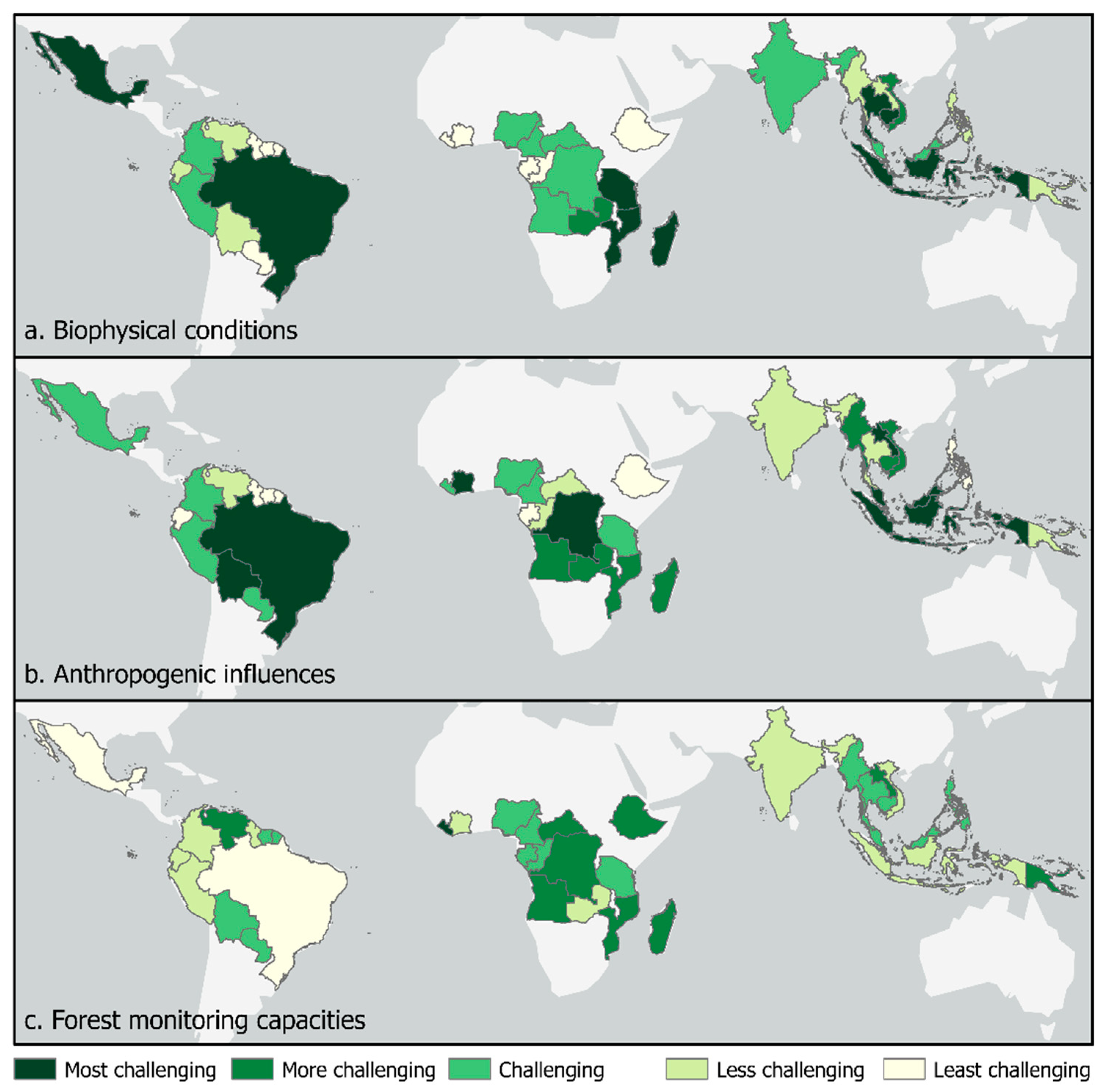
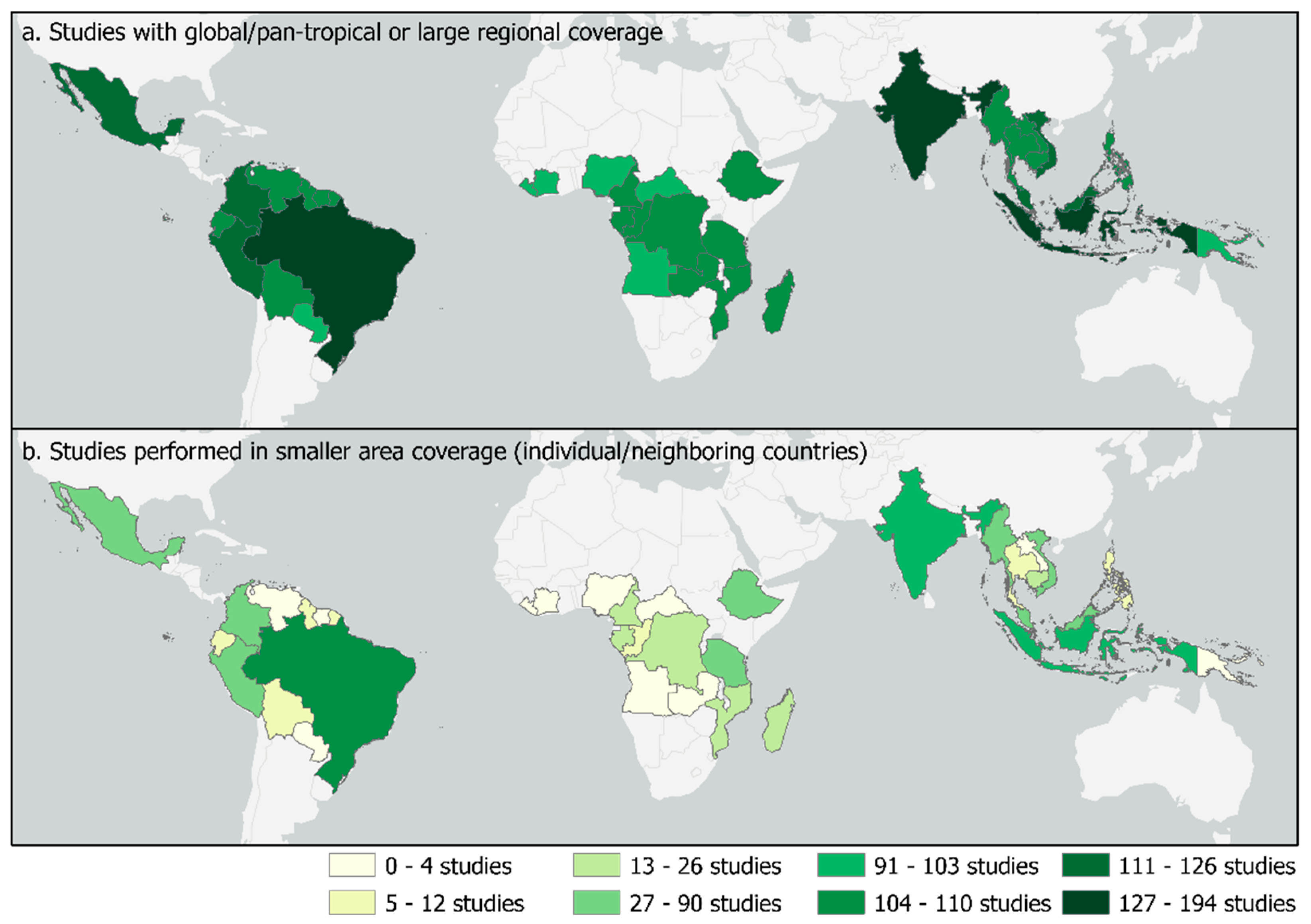
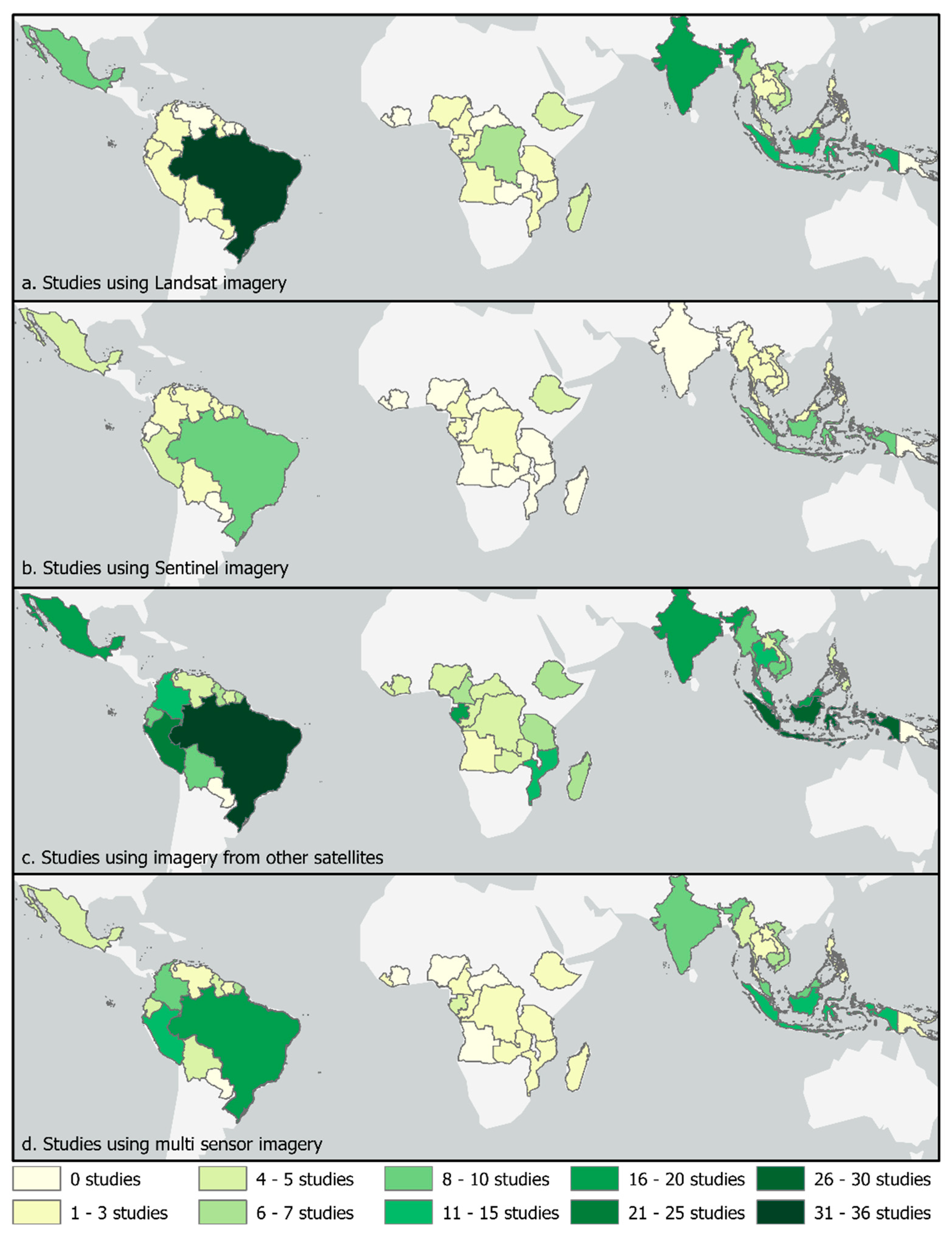
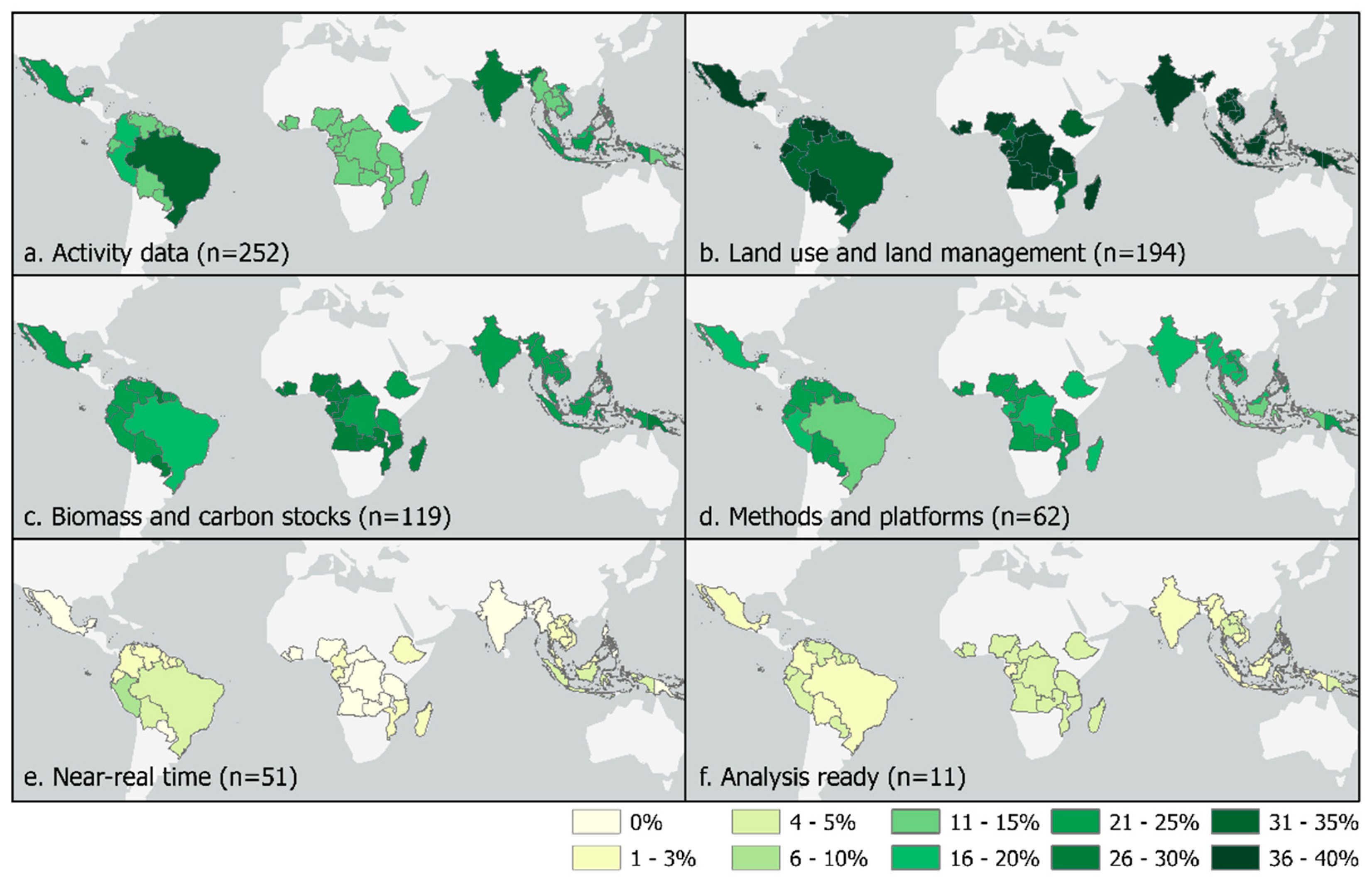
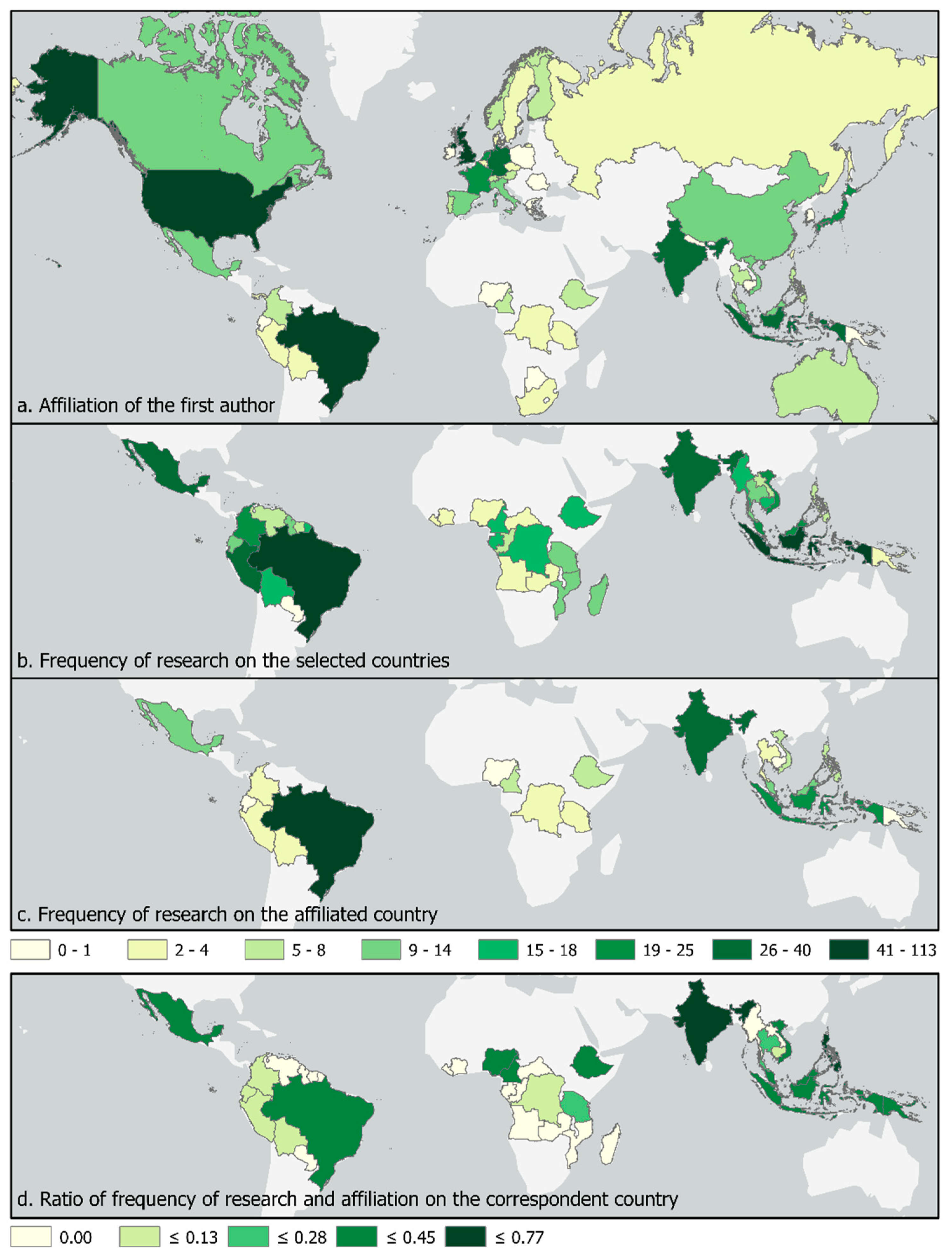
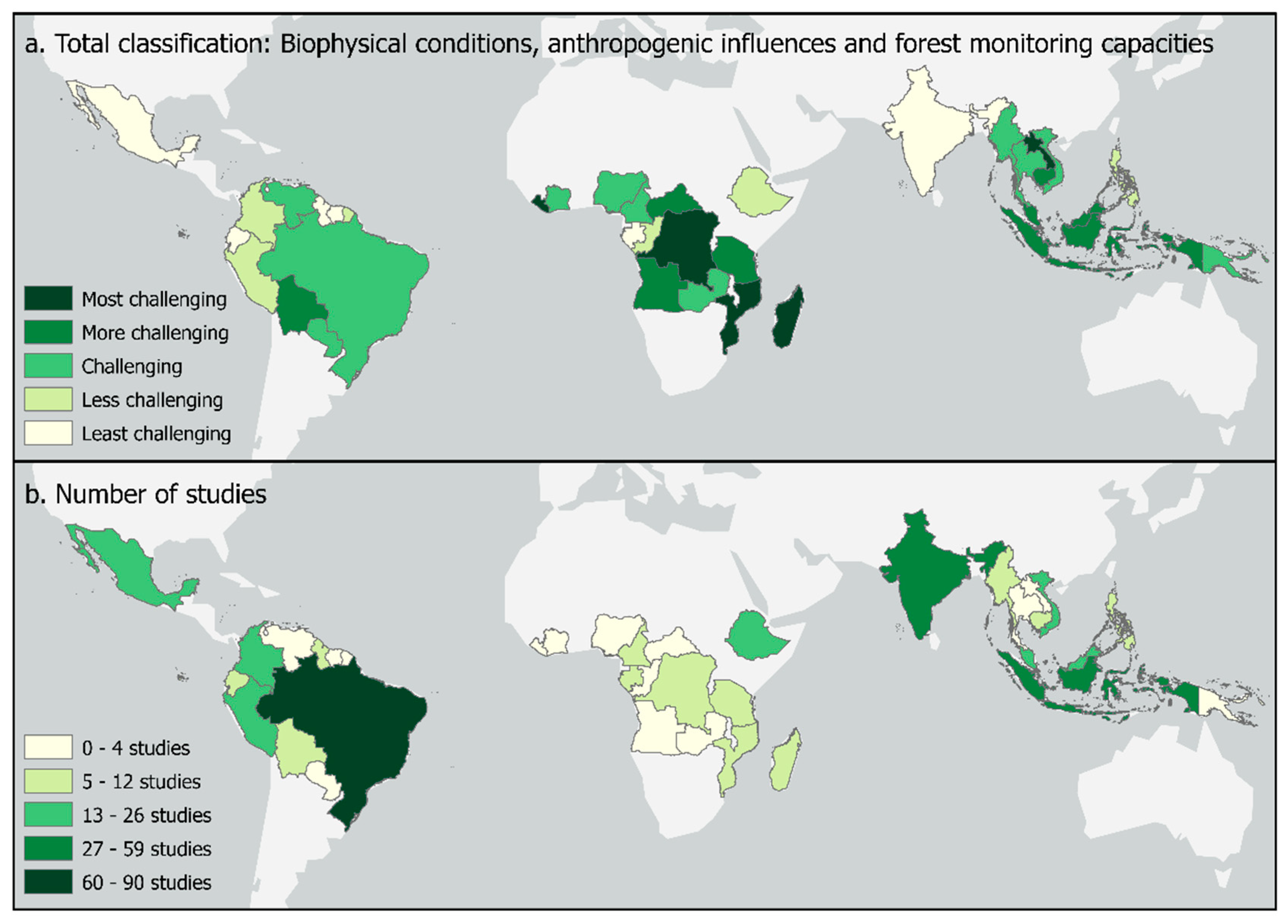
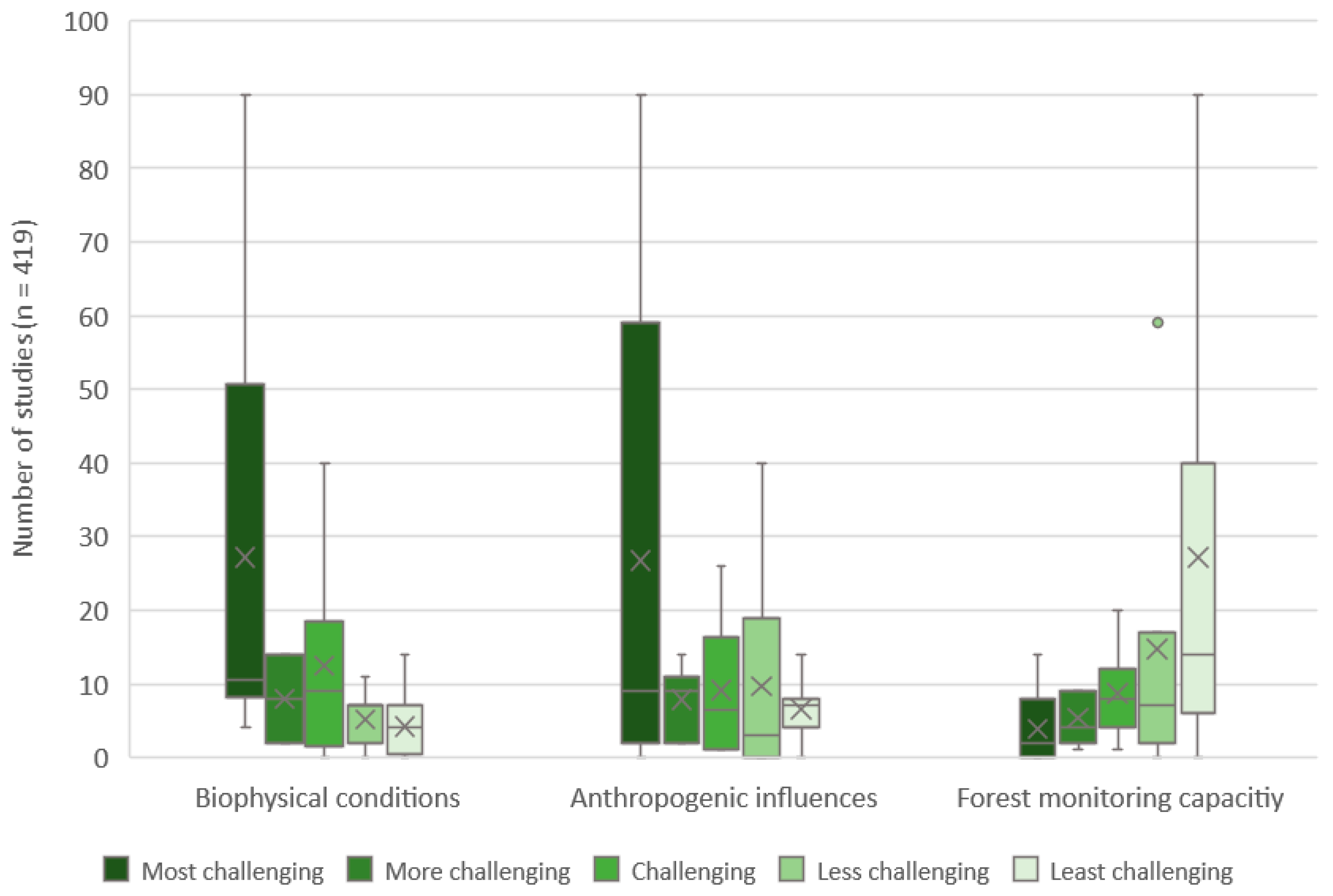
| Category | Study Types Included in the Category |
|---|---|
| Analysis-ready data | Studies related to analysis ready wall-to-wall satellite data and analysis ready high-resolution imagery. |
| Activity data | Studies related to the forest area and land use/cover change (deforestation), forest degradation, afforestation, and forest regrowth. |
| Land use and land management | Studies related to forest dynamics data, forest types, land use, management characteristics, and other sustainability-related forest parameters. |
| Biomass stocks and carbon emission | Studies related to forest biomass stocks and change and forest related GHG emissions and removals. |
| Near-real time alerting | Studies related to the use of near-real time imagery. |
| Methods and platforms | Studies developing for example methodologies related to uncertainty/accuracy assessment methods, and extraction of map statistics, and studies related to the exploration/development of platforms. |
| Criteria | Keywords and Search Expression |
|---|---|
| What? | “deforestation” OR “forest degradation” OR “forest disturbance” OR “forest monitoring” |
| How? | “remote sensing” OR “satellite imagery” OR “satellite data” |
| Where? | “forests” OR “tropical forests” OR “rain forest” OR “Angola” OR “Brazil” OR “Bolivia” OR “Cambodia” OR “Cameroon” OR “Central African Republic” OR “Colombia” OR “Cote d’Ivoire” OR “Democratic Republic of Congo” OR “Ecuador” OR “Ethiopia” OR “French Guiana” OR “Gabon” OR “Guyana” OR “India” OR “Indonesia” OR “Laos” OR “Liberia” OR “Madagascar” OR “Malaysia” OR “Mexico” OR “Mozambique” OR “Myanmar” OR “Nigeria” OR “Papua New Guinea” OR “Paraguay” OR “Peru” OR “Philippines” OR “Republic of Congo” OR “Suriname” OR “Tanzania” OR “Thailand” OR “Venezuela” OR “Vietnam” OR “Zambia” |
| When? | “2018” OR “2019” OR “2020” |
Publisher’s Note: MDPI stays neutral with regard to jurisdictional claims in published maps and institutional affiliations. |
© 2021 by the authors. Licensee MDPI, Basel, Switzerland. This article is an open access article distributed under the terms and conditions of the Creative Commons Attribution (CC BY) license (https://creativecommons.org/licenses/by/4.0/).
Share and Cite
Murrins Misiukas, J.; Carter, S.; Herold, M. Tropical Forest Monitoring: Challenges and Recent Progress in Research. Remote Sens. 2021, 13, 2252. https://doi.org/10.3390/rs13122252
Murrins Misiukas J, Carter S, Herold M. Tropical Forest Monitoring: Challenges and Recent Progress in Research. Remote Sensing. 2021; 13(12):2252. https://doi.org/10.3390/rs13122252
Chicago/Turabian StyleMurrins Misiukas, Jennifer, Sarah Carter, and Martin Herold. 2021. "Tropical Forest Monitoring: Challenges and Recent Progress in Research" Remote Sensing 13, no. 12: 2252. https://doi.org/10.3390/rs13122252
APA StyleMurrins Misiukas, J., Carter, S., & Herold, M. (2021). Tropical Forest Monitoring: Challenges and Recent Progress in Research. Remote Sensing, 13(12), 2252. https://doi.org/10.3390/rs13122252






